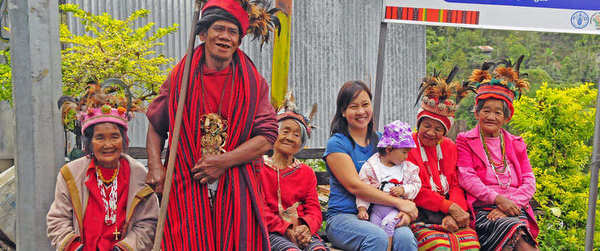
The Indigenous Peoples of the Philippines, their way of life, their culture and where they live in the Islands, may well be one of the most overlooked, yet very interesting, aspects of the entire Philippines! In the Highlands of Luzon, there is estimated to be 100 tribes and sub-tribes, who have preserved their lives much in the same way as was lived within their tribes centuries ago. Some of the more famous tribes in the Philippines are Igorot, Bontoc, Ifugao, Ibaloi, Tinguian and Isneg. One of the most beautiful and famous tourist attractions in the entire Philippines was built by the Ifugao. The Rice Terraces in Banaue!
While in Manila in the 1990s, I read the story in the Manila Bulletin Sunday Magazine about the Kalinga Tribe and sub-tribes, who live in Kalinga Province in northern Luzon. The chief was dressed in very colorful clothing and he wore two shrunken heads around his neck as a necklace. His tribe were former headhunters but the shrunken heads were from years past, handed down from chief to chief. These tribes supposedly no longer shrink human heads! That was good news because I just had to go to that area and check them out!
My great grandmother in Alabama was full Cherokee, so native and indigenous peoples in the Philippines are one of my interests. Buying and collecting the handicrafts of the many indigenous peoples is one of my hobbies!
Eata Tribe of Negros Occidental
Local Ilonggo people refer to the Eata Tribe as Ata. When the Spanish explorers first arrived on Negros Island, these native people were referred to as Negritos. Today, the Eata live in the highland forests of Negros Occidental and the forest is their life! They are food hunters and gathers, with the bow and arrow and spears as their weapons of choice. They are not a war-like people and it is safe to visit their areas of the Island. The Eata catch fish, mussels and gather the aquatic vegetables that grow in the rivers and streams in the mountains. They also do some farming and grow sweet potatoes and cassava.
Last year, I had the pleasure of meeting the Eata Chief, Gary Consing, at the Eata Exhibition held at the Negros Museum in Bacolod City. The Chief cannot speak English, so speaking directly to him was not possible. Chief Gary is proud that he and his people have preserved their ancient culture and way of life in Negros Occidental.
The Eata are involved with several commercial and income producing ventures. One is selling the forest honey that they have gathered from the bee hives. The cost is about P250 for a large bottle of this unique and natural forest honey. The Eata also make rattan bags and brooms. While some may see the Tribe as being poor, they consider themselves rich! The mountain forest provides most of their needs in their everyday lives and it also provides their income.
Some of the other tribes around the Philippines are more into making colorful clothing, jewelry, home decorations and food items.
If you are in an area of the Philippines where there is a reservation of indigenous people, which allows visitors, I highly recommend giving them a visit. It will be a trip you will not soon forget. Of course, not all indigenous people live on reservations in the Philippines, so you can visit them in their natural surroundings, usually in the mountain areas of the provinces. The local museums in cities usually know how to contact the tribes and will help you with your visit when a visit is allowed. Bacolod City and Iloilo in the Western Visayas both have a National Commission on Indigenous People office. They can also provide a wealth of information about them.
Go Tribal!
If you’d like to find out more about the Kalinga tribe and their amazing tattoos then there’s a great book available at Amazon.



Leave a Reply